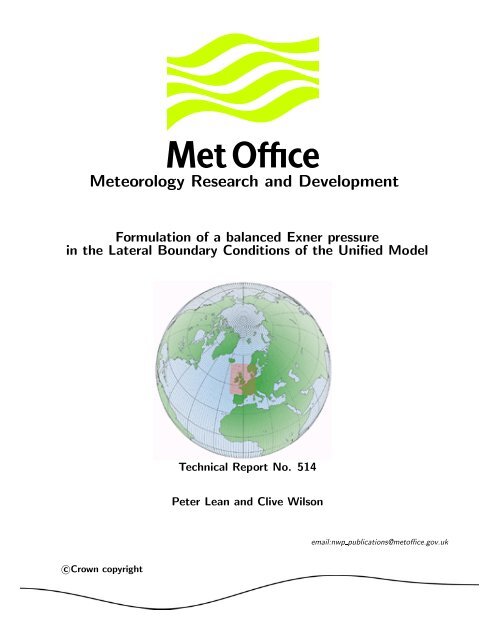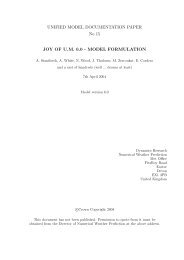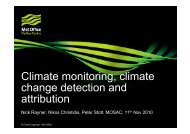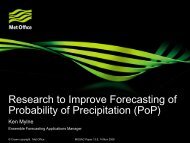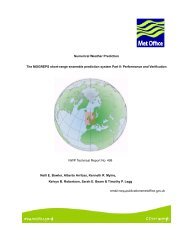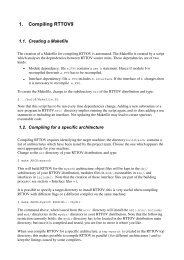Formulation of a balanced Exner pressure in the Lateral ... - Met Office
Formulation of a balanced Exner pressure in the Lateral ... - Met Office
Formulation of a balanced Exner pressure in the Lateral ... - Met Office
You also want an ePaper? Increase the reach of your titles
YUMPU automatically turns print PDFs into web optimized ePapers that Google loves.
<strong>Met</strong>eorology Research and Development<strong>Formulation</strong> <strong>of</strong> a <strong>balanced</strong> <strong>Exner</strong> <strong>pressure</strong><strong>in</strong> <strong>the</strong> <strong>Lateral</strong> Boundary Conditions <strong>of</strong> <strong>the</strong> Unified ModelTechnical Report No. 514Peter Lean and Clive Wilsonemail:nwp publications@met<strong>of</strong>fice.gov.ukc○Crown copyright
<strong>Formulation</strong> <strong>of</strong> a <strong>balanced</strong> <strong>Exner</strong> <strong>pressure</strong> <strong>in</strong> <strong>the</strong> <strong>Lateral</strong> Boundary Conditions<strong>of</strong> <strong>the</strong> Unified ModelPeter Lean and Clive WilsonDocument Change HistoryFirst draft, Peter Lean 22/06/2007Comments from Clive Wilson 04/03/2008Approved by Stuart Bell 05/03/20081
AbstractA new formulation <strong>of</strong> <strong>Exner</strong> <strong>pressure</strong> and density <strong>in</strong> <strong>the</strong> lateral boundaries conditions <strong>of</strong> limited areaconfigurations <strong>of</strong> <strong>the</strong> Unified Model is presented. This new formulation is designed for use when <strong>the</strong>vertical grid <strong>of</strong> <strong>the</strong> limited area model is different to that <strong>in</strong> <strong>the</strong> model used to provide those boundaryconditions. In <strong>the</strong>se situations, <strong>the</strong> dynamically <strong>balanced</strong> state <strong>in</strong> <strong>the</strong> driv<strong>in</strong>g model can becomedisrupted by vertical <strong>in</strong>terpolation onto <strong>the</strong> new vertical grid. The subsequent vertical accelerations <strong>in</strong><strong>the</strong> lateral boundary regions result<strong>in</strong>g from this imbalance can lead to high dynamics solver iterationcounts (<strong>in</strong>creas<strong>in</strong>g <strong>the</strong> run time <strong>of</strong> <strong>the</strong> forecasts) and, <strong>in</strong> some circumstances, a bias <strong>in</strong> <strong>the</strong> mean sealevel <strong>pressure</strong>.These problems were first noted <strong>in</strong> <strong>the</strong> operational NAE model after <strong>the</strong> <strong>in</strong>troduction <strong>of</strong> a newvertical grid <strong>in</strong> <strong>the</strong> global model. This report summarises <strong>the</strong> idealised experiments conducted toidentify <strong>the</strong> cause <strong>of</strong> <strong>the</strong>se problems, <strong>the</strong> use <strong>of</strong> imposed vertical balance as a solution and f<strong>in</strong>ally <strong>the</strong>implementation <strong>of</strong> this solution <strong>in</strong> <strong>the</strong> operational limited area forecast models.2
1 BackgroundS<strong>in</strong>ce <strong>the</strong> implementation <strong>of</strong> <strong>the</strong> non-hydrostatic New Dynamical core <strong>of</strong> <strong>the</strong> Unified Model <strong>in</strong> 2002(Davies et al., 2005), all operational forecast models at <strong>the</strong> <strong>Met</strong> <strong>Office</strong> have used <strong>the</strong> same 38 levelvertical grid. This situation changed when <strong>in</strong> November 2005 <strong>the</strong> Global model <strong>in</strong>creased to 50 levelswhich provided <strong>in</strong>creased resolution (particularly <strong>in</strong> <strong>the</strong> stratosphere) and <strong>the</strong> model top was raised toallow assimilation <strong>of</strong> more satellite radiance observations. This change <strong>in</strong> setup meant that <strong>the</strong> globalmodel had to perform vertical <strong>in</strong>terpolation <strong>in</strong> order to provide lateral boundary conditions on <strong>the</strong> lowerresolution vertical grid <strong>in</strong> <strong>the</strong> limited area models (LAMs).Problems were immediately noticed when <strong>the</strong> run-time <strong>of</strong> <strong>the</strong> North Atlantic and European (NAE)model <strong>in</strong>creased by around 25%. This run-time <strong>in</strong>crease was found to result from an <strong>in</strong>creased iterationcount <strong>in</strong> <strong>the</strong> dynamics Helmholtz solver. The problem was temporarily resolved by impos<strong>in</strong>g hydrostaticbalance <strong>in</strong> <strong>the</strong> <strong>Exner</strong> <strong>pressure</strong> and resett<strong>in</strong>g density us<strong>in</strong>g <strong>the</strong> equation <strong>of</strong> state. While this helped toreduce <strong>the</strong> iteration count to with<strong>in</strong> operationally acceptable levels, an undesirable side effect was <strong>the</strong><strong>in</strong>troduction <strong>of</strong> a 2hPa negative bias <strong>in</strong> <strong>the</strong> <strong>pressure</strong> at mean sea level (PMSL), as shown <strong>in</strong> Figure 1.Figure 1: Example <strong>of</strong> onset <strong>of</strong> <strong>the</strong> PMSL bias <strong>in</strong> <strong>the</strong> NAE when impos<strong>in</strong>g hydrostatic balance <strong>in</strong> <strong>the</strong> boundaries.Difference <strong>in</strong> PMSL [Pa] (NAE - global model) is shown dur<strong>in</strong>g <strong>the</strong> first few hours <strong>of</strong> <strong>the</strong> forecast.Several years earlier, <strong>the</strong> development <strong>of</strong> <strong>the</strong> High Resolution Trial Model (HRTM) required avertical resolution <strong>in</strong>crease with<strong>in</strong> <strong>the</strong> high-resolution nested model. It was decided that short-rangeforecasts <strong>of</strong> fog and low-cloud would benefit most from hav<strong>in</strong>g more vertical levels <strong>in</strong> <strong>the</strong> troposphereand <strong>in</strong> particular near <strong>the</strong> surface. Therefore, a new vertical levels set was constructed with <strong>in</strong>creasedresolution near <strong>the</strong> surface, but lower resolution <strong>in</strong> <strong>the</strong> stratosphere where <strong>the</strong> impact was expectedto be negligible. This model was <strong>the</strong>n run us<strong>in</strong>g lateral boundary conditions (LBCs) provided by <strong>the</strong>standard 38 level mesoscale model. However, it was soon noticed that <strong>the</strong> PMSL <strong>in</strong> <strong>the</strong> 4km modelwas about 8hPa higher than <strong>in</strong> <strong>the</strong> 12km driv<strong>in</strong>g model. This large PMSL bias associated with <strong>the</strong> use<strong>of</strong> vertically <strong>in</strong>terpolated LBCs appears to vary with <strong>the</strong> particular configuration <strong>of</strong> vertical grids usedby <strong>the</strong> driv<strong>in</strong>g and driven models.These two problems (high solver iteration count and PMSL bias) have been found to be caused by<strong>the</strong> same process. When runn<strong>in</strong>g a LAM on a different vertical grid from that <strong>of</strong> <strong>the</strong> driv<strong>in</strong>g model,3
<strong>the</strong> LBC data must be <strong>in</strong>terpolated onto <strong>the</strong> required grid; this vertical <strong>in</strong>terpolation <strong>of</strong> model variablescan result <strong>in</strong> a new model state which is no longer dynamically <strong>balanced</strong>. Any imbalance generatedby <strong>the</strong> action <strong>of</strong> <strong>in</strong>terpolation manifests itself as vertical accelerations along <strong>the</strong> lateral boundaries.These strong vertical accelerations can cause a reduction <strong>in</strong> <strong>the</strong> surface <strong>pressure</strong> and an <strong>in</strong>crease <strong>in</strong> <strong>the</strong>number <strong>of</strong> iterations required for <strong>the</strong> Helmholtz dynamics solver to converge on a stable solution.While forecasts <strong>of</strong> <strong>the</strong> large scale flow out to one week (made by <strong>the</strong> global model) can be benefitedby <strong>the</strong> use <strong>of</strong> extra satellite observations <strong>in</strong> <strong>the</strong> stratosphere and mesosphere (Walters et al., 2007), aforecast <strong>of</strong> <strong>the</strong> formation <strong>of</strong> fog or low cloud (<strong>in</strong> convective-scale model) may benefit more by hav<strong>in</strong>gmore vertical levels with<strong>in</strong> <strong>the</strong> boundary layer (Tardif, 2004; Bechtold et al., 1996). Future <strong>Met</strong> <strong>Office</strong>NWP plans <strong>in</strong>volve runn<strong>in</strong>g operational forecast models on different vertical grids <strong>in</strong> order to maximise<strong>the</strong> performance <strong>of</strong> each model over <strong>the</strong>ir target time period. Consequently, a solution to <strong>the</strong> problemsdescribed earlier were required. This report describes <strong>the</strong> work related to identify<strong>in</strong>g <strong>the</strong> cause <strong>of</strong> <strong>the</strong>seproblems, <strong>the</strong> proposed solution, followed by a summary <strong>of</strong> forecast trials lead<strong>in</strong>g to its operationalimplementation <strong>in</strong> <strong>the</strong> NAE after Parallel Suite 14 (March 2007).2 Idealised experiments to identify <strong>the</strong> causes <strong>of</strong> <strong>the</strong> problemThe operational NAE and <strong>the</strong> operational global model differ considerably <strong>in</strong> <strong>the</strong>ir setup. Apart from<strong>the</strong> obvious difference <strong>in</strong> <strong>the</strong>ir horizontal resolutions, many <strong>of</strong> <strong>the</strong> options <strong>in</strong> <strong>the</strong> dynamical core andparameterisation <strong>of</strong> physical processes also differ, along with <strong>the</strong> choice <strong>of</strong> surface and climatologicalancillary files, data assimilation systems and observations used. In a bid to isolate <strong>the</strong> factors caus<strong>in</strong>gthis problem, a highly idealised approach was adopted. The aim <strong>of</strong> this experiment was to reproduce<strong>the</strong> negative PMSL bias found when runn<strong>in</strong>g a limited area model on a different vertical grid from that<strong>of</strong> <strong>the</strong> global model and impos<strong>in</strong>g hydrostatic balance <strong>in</strong> <strong>the</strong> LBCs.2.1 Model setupAn idealised configuration <strong>of</strong> <strong>the</strong> Unified Model was used which shared <strong>the</strong> same dynamical core as <strong>the</strong>operational models, did not <strong>in</strong>clude parameterisation <strong>of</strong> sub-grid processes or moisture and ran fromidealised <strong>in</strong>itial conditions.To mimic <strong>the</strong> operational setup, an idealised global model was used to drive an idealised limitedarea model which ran on a different vertical grid. To isolate <strong>the</strong> action <strong>of</strong> vertical <strong>in</strong>terpolation <strong>in</strong> <strong>the</strong>generation <strong>of</strong> <strong>the</strong> LBCs as far as possible, <strong>the</strong> idealised LAM used exactly <strong>the</strong> same horizontal grid asthat <strong>of</strong> <strong>the</strong> idealised global model, i.e. <strong>the</strong> LAM had <strong>the</strong> same grid length and did not use a rotatedpole, such that grid po<strong>in</strong>ts <strong>in</strong> <strong>the</strong> LAM were simply a subset <strong>of</strong> those <strong>in</strong> <strong>the</strong> global model. A horizontalgrid spac<strong>in</strong>g <strong>of</strong> 0.833x0.554 degrees (N216 equivalent) was used <strong>in</strong> both models which resulted <strong>in</strong>432x325 grid po<strong>in</strong>ts <strong>in</strong> <strong>the</strong> global model and a 150x150 subset <strong>of</strong> <strong>the</strong>se, centred about <strong>the</strong> equator, <strong>in</strong><strong>the</strong> LAM (see Figure 2).A timestep <strong>of</strong> 20 m<strong>in</strong>utes was found to give numerically stable results and so no horizontal or verticaldiffusion was needed <strong>in</strong> <strong>the</strong>se idealised simulations. LBCs were updated every timestep so that anyeffects from a low update frequency <strong>in</strong> <strong>the</strong> LBCs was avoided. In every respect, o<strong>the</strong>r than <strong>the</strong> use <strong>of</strong>LBCs and a different vertical grid <strong>in</strong> <strong>the</strong> LAM, <strong>the</strong> setup <strong>of</strong> both model was identical. An aqua-planetsphere was adopted to remove <strong>the</strong> complications <strong>in</strong>troduced by <strong>the</strong> land surface and orography.The global model used 50 vertical levels where <strong>the</strong> thickness <strong>in</strong>creased quadratically with height(similar to <strong>in</strong> <strong>the</strong> operational models), whereas <strong>the</strong> limited area model used a 38 level equivalent (seeFigure 3). The eta levels used <strong>in</strong> <strong>the</strong>se idealised models were <strong>the</strong> same as those <strong>of</strong> <strong>the</strong> operational4
Global grid po<strong>in</strong>tsLAM grid po<strong>in</strong>tsFigure 2: Schematic to represent <strong>the</strong> grids <strong>of</strong> <strong>the</strong> global and limited area idealised models. Note that <strong>the</strong>LAM grid is effectively just a sub-set <strong>of</strong> <strong>the</strong> global grid po<strong>in</strong>ts with <strong>the</strong> horizontal resolution and grid positionsbe<strong>in</strong>g identical.Figure 3: Model θ levels used <strong>in</strong> <strong>the</strong> idealised global model (left) and limited area models (right).5
models; however <strong>the</strong> lids <strong>of</strong> each had to be lowered to allow <strong>the</strong> use <strong>of</strong> <strong>the</strong> geostrophically, hydrostatically<strong>balanced</strong> <strong>in</strong>itial conditions.It is worth not<strong>in</strong>g that <strong>the</strong> cod<strong>in</strong>g <strong>of</strong> <strong>the</strong> reconfiguration had to be altered for <strong>the</strong>se experiments toprevent hydrostatic balance from be<strong>in</strong>g imposed across <strong>the</strong> whole doma<strong>in</strong> as this could complicate <strong>the</strong><strong>in</strong>terpretation <strong>of</strong> <strong>the</strong> results.2.2 Initial conditionsA both hydrostatically and geostrophically <strong>balanced</strong> <strong>in</strong>itial state was provided by a westerly jet follow<strong>in</strong>ga cos<strong>in</strong>e pattern, peak<strong>in</strong>g at 50ms −1 , centred on <strong>the</strong> equator (see Figure 4) with an exponential decrease<strong>of</strong> <strong>pressure</strong> and an exponential <strong>in</strong>crease <strong>of</strong> potential temperature (Figure 5) with height. This is,<strong>the</strong>oretically, a steady-state solution.Figure 4: Initial u-component <strong>of</strong> <strong>the</strong> w<strong>in</strong>d [ms −1 ] <strong>in</strong> <strong>the</strong> idealised global simulation.(a)(b)Figure 5: Initial pr<strong>of</strong>iles <strong>of</strong> (a) potential temperature and (b) <strong>Exner</strong> <strong>pressure</strong>, <strong>in</strong> <strong>the</strong> idealised global simulationat <strong>the</strong> pole (solid) and at <strong>the</strong> equator (dashed).6
Figure 6: PMSL difference [Pa] between <strong>the</strong> LAM and <strong>the</strong> global at <strong>the</strong> end <strong>of</strong> timestep 1 (top) and timestep9 (bottom). This was from <strong>the</strong> simulation where hydrostatic balance was imposed <strong>in</strong> <strong>the</strong> LBCs, but not <strong>in</strong><strong>the</strong> reconfigured start dump.2.3 Reproduc<strong>in</strong>g <strong>the</strong> problemThe <strong>in</strong>itial aim <strong>of</strong> <strong>the</strong> experiment was to reproduce, <strong>in</strong> this idealised environment, <strong>the</strong> negative PMSLbias found <strong>in</strong> <strong>the</strong> operational forecasts when impos<strong>in</strong>g hydrostatic balance <strong>in</strong> <strong>the</strong> LBCs. While <strong>the</strong>global model rema<strong>in</strong>ed <strong>in</strong> a steady-state (as expected from <strong>the</strong>ory), <strong>the</strong> LAM showed waves generatedalong <strong>the</strong> boundaries which spread across <strong>the</strong> doma<strong>in</strong>. Figure 6 shows <strong>the</strong> difference <strong>in</strong> PMSL between<strong>the</strong> idealised limited area model and <strong>the</strong> global model. It can be seen that a negative PMSL bias isestablished around <strong>the</strong> boundaries which <strong>the</strong>n spreads <strong>in</strong>to <strong>the</strong> <strong>in</strong>terior <strong>of</strong> <strong>the</strong> doma<strong>in</strong>, <strong>in</strong> a very similarfashion to that <strong>in</strong> <strong>the</strong> operational forecasts (see Figure 1). The phase speed <strong>of</strong> <strong>the</strong>se waves <strong>in</strong>dicatesthat <strong>the</strong>se are shallow water gravity waves. This experiment successfully reproduced <strong>the</strong> problem be<strong>in</strong>g<strong>in</strong>vestigated, allow<strong>in</strong>g <strong>the</strong> causes to be diagnosed free from <strong>the</strong> complexities <strong>of</strong> <strong>the</strong> full operationalsetup.As <strong>the</strong> source <strong>of</strong> <strong>the</strong> PMSL bias was evidently <strong>the</strong> boundaries <strong>of</strong> <strong>the</strong> doma<strong>in</strong>, fur<strong>the</strong>r attention waspaid to <strong>the</strong>se regions. Figure 7 shows a cross-section along <strong>the</strong> equator <strong>of</strong> <strong>the</strong> vertical velocity at <strong>the</strong>7
The vertical velocities seen at <strong>the</strong> end <strong>of</strong> <strong>the</strong> first timestep must have resulted from an imbalance<strong>of</strong> <strong>the</strong> terms <strong>in</strong> this equation. In <strong>the</strong> operational and idealised setups, hydrostatic balance is imposedon <strong>the</strong> LBCs, i.e. <strong>the</strong> <strong>Exner</strong> <strong>pressure</strong> pr<strong>of</strong>ile is adjusted such that <strong>the</strong> acceleration due to <strong>the</strong> vertical<strong>pressure</strong> gradient (term E) is equal and opposite to <strong>the</strong> acceleration due to gravity (term D). If <strong>the</strong> o<strong>the</strong>rterms are considered negligible <strong>the</strong>n this can be expected to lead to state with no vertical accelerations.Appendix A shows that <strong>the</strong> accelerations due to <strong>the</strong> vertical component <strong>of</strong> <strong>the</strong> coriolis force (term C)and <strong>the</strong> metric term (term B) <strong>in</strong> equation 1 are not negligible <strong>in</strong> this case and lead to <strong>the</strong> spuriousvertical accelerations. Apparently, <strong>the</strong>se vertical accelerations lead to a reduction <strong>in</strong> <strong>the</strong> air density near<strong>the</strong> surface (due to cont<strong>in</strong>uity) and hence a reduction <strong>in</strong> <strong>pressure</strong> at mean sea-level (via <strong>the</strong> equation<strong>of</strong> state).i.e. it is hypo<strong>the</strong>sised that <strong>in</strong> a non-stationary, hydrostatically <strong>balanced</strong> atmosphere, <strong>the</strong>vertical coriolis and metric terms <strong>in</strong> <strong>the</strong> New Dynamics formulation can result <strong>in</strong> significantvertical accelerations. When <strong>the</strong>se conditions are imposed <strong>in</strong> <strong>the</strong> LBCs <strong>of</strong> <strong>the</strong> UM thiscan lead to surface <strong>pressure</strong> biases and <strong>in</strong>crease <strong>the</strong> number <strong>of</strong> iterations needed for <strong>the</strong>dynamics solver to converge on a stable solution.3.1 Test<strong>in</strong>g <strong>the</strong> hypo<strong>the</strong>sis: impos<strong>in</strong>g a more precise balanceIf vertical accelerations are <strong>the</strong> cause for <strong>the</strong> PMSL bias and high iteration counts <strong>the</strong>n <strong>the</strong> obvioussolution would be to impose dynamical balance <strong>in</strong> <strong>the</strong> vertical to ensure that <strong>the</strong>se accelerations donot occur, i.e. balance all <strong>the</strong> terms <strong>in</strong> <strong>the</strong> vertical momentum equation to prevent <strong>the</strong>se accelerationsfrom occurr<strong>in</strong>g (shown schematically <strong>in</strong> Figure 8).c pθ vδΠδru 2 + v 22 Ωu cosφrgFigure 8: Schematic to show <strong>the</strong> forces caus<strong>in</strong>g vertical accelerations <strong>in</strong> <strong>the</strong> New Dynamics formulation <strong>of</strong><strong>the</strong> UM.We want DwDt= 0, <strong>the</strong>refore equation 1 becomes,(u 2 rot + v2 rot )r− f 1 v rot + f 2 u rot − g − c pd θ v∂Π∂r = 0∂Πc pd θ v∂r = (u2 rot + vrot)2 − f 1 v rot + f 2 u rot − g (2)r9
3.2 Implementation <strong>in</strong> <strong>the</strong> Unified ModelThis solution was implemented <strong>in</strong> <strong>the</strong> UM as a new subrout<strong>in</strong>e BALANCE LBC VALUES, which adjusts<strong>the</strong> <strong>Exner</strong> pr<strong>of</strong>iles <strong>in</strong> <strong>the</strong> LBCs at <strong>the</strong> beg<strong>in</strong>n<strong>in</strong>g <strong>of</strong> each timestep. LBC data are output from <strong>the</strong> driv<strong>in</strong>gmodel as normal. These data are read <strong>in</strong> by <strong>the</strong> limited area model. At <strong>the</strong> beg<strong>in</strong>n<strong>in</strong>g <strong>of</strong> each timestep,balance is applied to prevent spurious vertical accelerations. Details <strong>of</strong> <strong>the</strong> exact method <strong>of</strong> adjust<strong>in</strong>g<strong>the</strong> <strong>Exner</strong> pr<strong>of</strong>iles is provided below. F<strong>in</strong>ally, <strong>the</strong> model values along <strong>the</strong> boundaries are blended with<strong>the</strong> LBC values.The UM grid is staggered on an Arakawa C-grid <strong>in</strong> <strong>the</strong> horizontal and a Charney-Phillips grid <strong>in</strong> <strong>the</strong>vertical. Equation 2 is discretised as follows,( )c pd θvk Π k+1 − Π k u 2 rot + v2 rot=− frρk+1 − rρk rθk 1 v rot + f 2 u rot − g (3)where horizontal and vertical <strong>in</strong>terpolation <strong>of</strong> <strong>the</strong> w<strong>in</strong>ds onto θ po<strong>in</strong>ts is carried out as follows,( 1u i,j = w 12 u i−1,j,k + 1 ) ( 12 u i,j,k + w 22 u i−1,j,k+1 + 1 )2 u i,j,k+1 .Indices, i, j, k, <strong>in</strong>dicate <strong>the</strong> horizontal and vertical location <strong>of</strong> a grid po<strong>in</strong>t, and w 1 and w 2 are<strong>in</strong>terpolation coefficients. At <strong>the</strong> top model level, an upper boundary condition is applied, u N =u Nand v N =v N . Equation 3 can be re-arranged to allow a <strong>balanced</strong> <strong>Exner</strong> pr<strong>of</strong>ile to be constructed by<strong>in</strong>tegrat<strong>in</strong>g from <strong>the</strong> lowest model level upwards, given <strong>the</strong> pr<strong>of</strong>iles <strong>of</strong> potential temperature and w<strong>in</strong>d,Π k+1 = Π k + rk+1 ρ − rρkc pd θvk⎛⎝( )u 2 rot + v2 rotr k θ⎞− f 1 v rot + f 2 u rot − g⎠ .Issues arise when <strong>in</strong>terpolat<strong>in</strong>g <strong>the</strong> u and v w<strong>in</strong>ds horizontally due to <strong>the</strong> way LBC data are stored<strong>in</strong> <strong>the</strong> UM. LBC data are stored <strong>in</strong> memory sequentially <strong>in</strong> four segments; north, south, east and west.For po<strong>in</strong>ts near <strong>the</strong> edge <strong>of</strong> each segment, it is sometimes necessary to retrieve data from a differentLBC segment (e.g. see Figure 9) and so care had to be taken <strong>in</strong> to ensure that <strong>the</strong> data was addressedcorrectly.It is recognised that to impose a truly <strong>balanced</strong> state, <strong>the</strong> atmospheric state should be calculatedsuch that it rema<strong>in</strong>s <strong>balanced</strong> after pass<strong>in</strong>g through <strong>the</strong> semi-implicit, semi-Lagrangian dynamics <strong>of</strong><strong>the</strong> UM. The methodology adopted here would only be exact when used with an explicit time-stepp<strong>in</strong>gscheme, i.e. if <strong>the</strong> model dynamics used <strong>the</strong> same time-stepp<strong>in</strong>g scheme as <strong>the</strong> method used here.While this method will mean that <strong>the</strong> balance imposed is not exact, <strong>the</strong> results <strong>in</strong>dicate that <strong>the</strong><strong>in</strong>accuracy <strong>of</strong> <strong>the</strong> method is smaller than <strong>the</strong> imbalance which is caus<strong>in</strong>g <strong>the</strong> problem and so providesa significant improvement. The implementation <strong>of</strong> a scheme to impose an exact balance match<strong>in</strong>g<strong>the</strong> UM dynamics would prove substantially more computationally expensive than <strong>the</strong> relatively cheapscheme adopted here.After <strong>the</strong> <strong>Exner</strong> <strong>pressure</strong> pr<strong>of</strong>iles have been changed, <strong>the</strong> density must also be <strong>balanced</strong> such that<strong>the</strong> equation <strong>of</strong> state is obeyed. i.e.ρ =p 0κ d c pd θ v Π κ d −1κ dwhere κ d = R dc pd.While <strong>the</strong> New Dynamics employs a l<strong>in</strong>earised form <strong>of</strong> <strong>the</strong> equation <strong>of</strong> state, <strong>the</strong> differences result<strong>in</strong>gfrom this different def<strong>in</strong>ition were found to be negligible.10
FC−Obs Mean ErrorFC−Obs RMS ErrorMean Sea Level Pressure (Pa): Surface ObsMeaned from 30/1/2007 00Z to 19/2/2007 18ZCases: NAE Parallel NAE Oper Global Oper Global ParallelAreas:Reduced NAE Model area0350300−50250−100200150−150100−2000 12 24 36 48Forecast Range (hh)500 12 24 36 48Forecast Range (hh)Figure 13: PS14 verification: PMSL mean error (left panel) and RMS error (right panel) [Pa]. The operationalNAE (blue) quickly develops a negative PMSL bias, where as <strong>the</strong> trial NAE (red) forecast is much closer tothat <strong>of</strong> <strong>the</strong> global model.6 ConclusionProblems caused by <strong>the</strong> l<strong>in</strong>ear <strong>in</strong>terpolation <strong>in</strong> height <strong>of</strong> <strong>Exner</strong> <strong>pressure</strong>, potential temperature anddensity to create LBCs on a different vertical grid from that <strong>of</strong> <strong>the</strong> driv<strong>in</strong>g model have been identifiedwith <strong>the</strong> use <strong>of</strong> an idealised setup <strong>of</strong> <strong>the</strong> UM and solved by impos<strong>in</strong>g vertically <strong>balanced</strong> pr<strong>of</strong>iles <strong>of</strong><strong>Exner</strong> <strong>pressure</strong> and density <strong>in</strong> <strong>the</strong> LBCs. The solution provided has successfully removed anomalouslyhigh dynamics solver iteration counts <strong>in</strong> <strong>the</strong> LAMs, with a subsequent reduction <strong>in</strong> operational runtime<strong>of</strong> <strong>the</strong> NAE <strong>of</strong> 5%. Similarly, a PMSL bias (experienced with certa<strong>in</strong> comb<strong>in</strong>ations <strong>of</strong> vertical levels <strong>in</strong><strong>the</strong> driv<strong>in</strong>g and driven model) has been significantly reduced <strong>in</strong> <strong>the</strong> LAM forecasts result<strong>in</strong>g <strong>in</strong> improvedguidance <strong>in</strong> high resolution, short-range forecasts. It has been shown that impos<strong>in</strong>g hydrostatic balance<strong>in</strong> <strong>the</strong> LBCs is <strong>in</strong>sufficient as accelerations result<strong>in</strong>g from <strong>the</strong> vertical coriolis force still lead to spuriousvertical accelerations large enough to create a reduction <strong>in</strong> sea level <strong>pressure</strong>. To prevent <strong>the</strong>se verticalaccelerations, all <strong>the</strong> terms <strong>in</strong> <strong>the</strong> vertical momentum must be <strong>balanced</strong>. These changes have beensuccessfully implemented operationally <strong>in</strong> <strong>the</strong> NAE and <strong>the</strong> CAMMs and have become a standard optionafter UM6.5.The use <strong>of</strong> <strong>balanced</strong> lateral boundary conditions allows a free choice <strong>of</strong> vertical grid <strong>in</strong> each model.This freedom should provide benefits not only for <strong>the</strong> operational wea<strong>the</strong>r forecasts but also for regional14
climate modellers who may wish to use a higher resolution vertical grid <strong>in</strong> <strong>the</strong>ir limited area simulations.It is suggested that <strong>the</strong> results from this work may also be applicable to o<strong>the</strong>r non-hydrostatic NWPmodels when LBCs are provided by ano<strong>the</strong>r model on a different vertical grid and/or with a differentdynamical formulation.15


